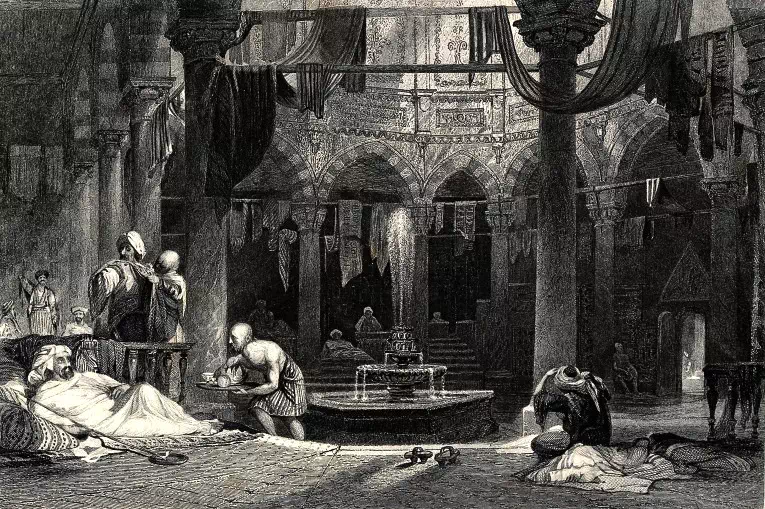

Turkish baths have played a crucial role in daily life and culture for centuries. These baths, influenced by ancient Roman and Byzantine traditions, became an important part of Ottoman bath culture. Over time, the evolution of Turkish bath traditions led to the creation of great baths, which remain an essential part of Turkey's heritage. Today, Turkish baths are not only places of cleansing, but also popular attractions for tourists seeking an authentic historical and cultural experience.
The origins of Turkish baths date back to the Roman Empire, where communal bathing was a daily ritual. Public baths, known as “thermae,” were widespread and the concept of cleansing as a social activity was deeply rooted in Roman society. After the spread of Islam, this bathing culture merged with religious practices of purification, shaping the baths we know today. These traditional baths in Istanbul and other parts of the Ottoman Empire served not only as places of cleansing, but also as social centers where people gathered to relax, exchange news and hold business conversations.
Ottoman culture of the Turkish baths
During the Ottoman period, Turkish baths flourished. Sultans and wealthy patrons commissioned the construction of elaborate bathhouses, often designed by famous architects such as Mimar Sinan. These bathhouses featured a distinctive architectural style with large domes, intricate tiles and marble interiors. They became spaces for relaxation, socializing and even for important life events such as wedding baths and newborn ceremonies. Women, in particular, found the Turkish baths a place for leisure and an opportunity to bond with other members of their community. The hammam also played a role in health and medicine, as it was believed that the steam and heat could help alleviate various ailments.
Evolution of hammam traditions
As modernity progressed, the role of Turkish toilets began to change. While they were once essential for daily hygiene, modern plumbing reduced their need. However, historic Turkish baths continued to attract visitors seeking a traditional wellness experience. Many Turkish baths have been restored, combining ancient bathing practices with modern spa amenities. Today, visitors can choose between traditional baths that have retained their authentic structure and modern baths that offer additional services such as aromatherapy, hot stone massages and skin care treatments. The Turkish bath experience has become synonymous with self-care, relaxation and a luxurious escape from the stresses of everyday life.
Traditional baths in Istanbul
Istanbul is home to some of the most famous historic Turkish baths, such as the Cemberlitas Hammam and the Hurrem Sultan Hammam. These iconic establishments are still in operation today and preserve the essence of Ottoman hammam culture. Visitors can experience a traditional hammam ritual, which includes a steam bath, exfoliation and a relaxing foam massage. Many of these baths have adapted to modern tourism and offer bilingual staff, private rooms and personalized services to cater to international guests. The architectural beauty of these hammams also makes them a must-see, offering a glimpse into the splendor of the Ottoman era.
The ritual of a traditional hammam experience
A visit to a Turkish hammam usually follows a structured process. First, guests enter the “soyunmalık” (changing room) where they put on a “pestemal” (a traditional cotton towel). They then proceed to the “hararet” (hot room), where they relax on a heated marble slab known as a “göbek taşı”. The heat helps to open the pores and loosen the muscles, preparing the body for the next step. After sweating, guests receive an exfoliating scrub (“kese”) performed by an attendant, followed by a rich lathering massage with natural olive oil soap. Finally, they rinse off with cooler water before moving on to a relaxation area, where they enjoy a tea or soft drink. This ritual not only cleanses the body, but also revitalizes the mind and soul.
Conclusion
The transformation of the Turkish baths reflects a fascinating journey through history. While their primary function has evolved, their cultural and architectural significance remains intact. Whether for relaxation, tradition or historical exploration, Turkish baths remain a timeless part of Turkish heritage. If you visit Turkey, experiencing an authentic Turkish bath is a must! The warmth of marble, refreshing exfoliation and soothing foam massage create a unique experience that connects visitors to centuries-old traditions.
This website uses cookies. By using this website and agreeing to this policy, you consent to our use of cookies in accordance with the terms of this policy.
Cookies are small text files that are placed on your computer by websites that you visit. They are widely used in order to make websites work, or work more efficiently, as well as to provide information to the owners of the site.
We use cookies to:
1. Strictly Necessary Cookies: These are essential in order to enable you to move around the website and use its features.
2. Performance Cookies: These cookies collect information about how visitors use a website, for instance which pages visitors go to most often.
3. Functionality Cookies: These cookies allow the website to remember choices you make and provide enhanced, more personal features.
4. Targeting/Advertising Cookies: These cookies are used to deliver adverts more relevant to you and your interests.
You can control and/or delete cookies as you wish. You can delete all cookies that are already on your computer and you can set most browsers to prevent them from being placed. If you do this, however, you may have to manually adjust some preferences every time you visit a site and some services and functionalities may not work.